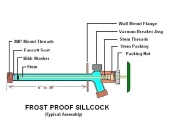posted 2 years ago
I've decided to move into a 150-year-old house. I knew there would be issues to progressively tackle, and I am cool with that. Until I am not.
Maybe everyone noticed the major freeze the U.S. had a little while ago? I certainly did and my wood stove was on top of it. Buuuuut, the main water line, where it comes into the stone cellar is just next to the steps coming down from the cellar doors. Ice wind swept into the cellar and froze the connection of the cast iron pipe (coming out of the stone wall) and a hose (???) to the rest of the plumbing system.
Still, not a big deal. A space heater and curtain to block the inside entrance of the cellar from the wind and the water flowed again. Buuuut... the seal was damaged, and water has been leaking from, not actually the connection, but the edge of the cast iron pipe just BEFORE the connection to the hose. Okay, it's an old house and this was bound to happen. I was already dealing with a blocked cast iron sewage pipe for the kitchen sink. The plumber I brought in, long before the freeze, estimated to clear the block and replace the cast iron and marry it to PVC would be over $700. He had replaced the pipes under the sink (which was not what I had asked him to do, but my fault for not micromanaging) and charged me $400 for that! (I called him to clear the block. No, it still isn't clear.)
I know, I veered off there. Since this new leak could be very costly, I called the plumber. No response, no voicemail. Called another. No response, no voice mail. Called another. This one told me to procreate with myself because I was 45 minutes away from his location. (I live in a very rural area.) Another said I could go on a waiting list but she didn't think they would ever come out my way. The final option I had was a national company, that would schedule me, then cancel hours later. (I argued with the lady the last time it happened, and she basically told me I was a waste of time and money because I was too far.)
So now I have a leaking water main. Well, I duct taped the heck out of it so now it slowly drips, but that still counts as a leak. And I have a sewage pipe that is blocked. Both are cast iron. If it were copper, or PVC, I'd have no issue attempting to replace/repair myself, but they are big, rusty, cast-iron pipes. I'm not sure I won't make the situations worse. But I don't know really how to fix them. I checked the forums and found nothing on cast iron pipes. (Maybe I didn't look hard enough.) But I was thinking of trying to cut and replace the kitchen sink pipe, where it connects to the sewage with PVC and marry it with a Fernco coupling? I think that is right.
I think if I screw that up, it's a drain and a sink. A pain, sure, but not the end of the world. If I successfully fix it, then I could try the main? I don't know. Is there another way to fix a cast-iron pipe that is rusted through? And what do I use to cut the pipe?
I appreciate any suggestions.

 3
3




 2
2




 5
5








 1
1




 3
3




 2
2




 1
1





 3
3





 2
2




 1
1








 2
2




 1
1




 1
1




 4
4









